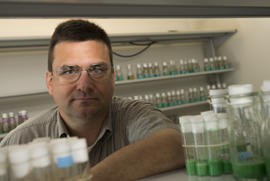Systematic study of key protein could lead to better understanding and treatment of HSP
Rice University biochemist James McNew has gotten used to doing research on the fly, but he no longer has to do it on a shoestring thanks to a new grant from the National Institutes of Health.
The new four-year $1.4 million R01 grant is for the study of a protein called atlastin, a key player in the genetic disorder hereditary spastic paraplegia (HSP).
In going after the grant, McNew, associate professor of biochemistry and cell biology, took a risk. He abandoned his laboratory’s long-standing model organism — single-celled yeast — in favor of studying fruit flies.

Rice University biochemist James McNew took a risk and changed his lab's model organism from yeast to fruit flies to study a key protein that's been linked to hereditary spastic paraplegia. The gamble paid off with a new grant from the National Institutes of Health.
“It’s a relief to finally have some dedicated funding for this,” McNew said. “This grant gives us the ability undertake some of the more in-depth investigations into atlastin that we’ve had our eye on for a while.”
McNew said he hopes the study of atlastin will reveal new clues about HSP and perhaps point to new ways of treating it. HSP is a group of inherited neurological disorders that affect about 20,000 people in the United States. The disease is marked by the slow degeneration of nerves that carry signals from the spinal column to the legs, feet and toes.
As many as 40 defective genes have been linked with HSP, but one gene in particular has been linked to as many as 10 percent of all HSP cases. That mutation is to the gene that produces atlastin, and McNew’s lab is one of a handful worldwide trying to find out how atlastin works and why atlastin defects cause HSP.
For McNew, the quest to untangle atlastin’s mysteries began about four years ago with a phone call.
“Andrea Daga called me from the Medea Institute (in Italy) to see if our group could apply some of our methods to determine whether atlastin could cause membrane fusion,” McNew said.
At the time, McNew’s lab studied SNAREs, proteins that act something like a loading dock manager to help regulate the flow of “cargo” through the cell’s internal membrane system. SNAREs are one of the few proteins that can promote membrane fusion — a process that leads to the formation of tiny, temporary doorways through the cell’s membranes.
Daga asked for McNew’s help in studying atlastin because some of its traits suggested it might also be a membrane fusion protein. The pair confirmed that to be true in 2009, and they have continued collaborating to piece together a bigger picture of how atlastin works.
“We discovered that atlastin plays a key role in building and maintaining an important internal compartment of healthy cells called the endoplasmic reticulum,” McNew said.
That find was critical because HSP is known to affect some of the longest cells in the body. McNew said it is possible that defective atlastin leads to defects in the endoplasmic reticulum (ER), and if that’s true, the effects might be more likely to affect long nerve cells that have lots of ER. For now, that’s still a hypothesis, and McNew said the new grant will help him and his students find some of the evidence needed to test the hypothesis.
For example, McNew’s group at Rice’s BioScience Research Collaborative will investigate the basic mechanism that atlastin uses to fuse together pieces of the ER. In one series of experiments, they will create a number of mutant atlastin proteins, each with a defect designed to make the protein malfunction in a specific way. By studying how each of these mutations affects the ability of atlastin to drive membrane fusion, the team hopes to build up a better understanding of how healthy atlastin does its job.
“If we can find some of the answers to how atlastin works, it could answer some fundamental questions about HSP,” McNew said.


Leave a Reply